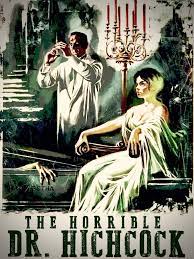
Professor Bernard Hichcock (Robert Flemyng) is a famous physician in London during 1885. He has been experimenting with anesthesia and has saved lives using it. Hichcock is also a necrophiliac whose wife, Margaretha (Maria Teresa Vianello), indulges his desires by allowing him to anesthetize her during sex so he can live out his fantasies. One day he uses more anesthesia than he should and inadvertently kills her. Traumatized by the event he leaves his servant Martha (Harriet Medin) to care for the manor house and abandons his practice and his home. Margaretha is buried in the family crypt.
Twelve years later he returns with a new wife, Cynthia (Barbara Steele). Martha, having been devoted to Margaretha doesn’t take too well to Cynthia. Cynthia, in turn, feels uneasy and unwelcome in the massive and cold house. Portraits of Margaretha decorate many of the rooms and Bernard begins to withdraw from her. Cynthia starts to hear strange noises and sees the fleeting glimpse of a spectral woman on the grounds. She begins to feel that the house is haunted.
Bernard’s behavior is beginning to affect his work, and his assistant, Dr. Kurt Lowe (Silvano Tranquilli), is beginning to suspect that there is something wrong with the brilliant professor. At home Bernard is starting up his sex games but using a drugged Cynthia as a play toy. Cynthia is not aware of what happened when she was unconscious but at one point awakens and sees her husband leering over her prone body. She is beginning to fear for her life. In addition, Martha has a secret that will send Hichcock over the edge and want to commit murder.
“The Horrible Doctor Hichcock” AKA “Raptus: The Secret of Dr. Hichcock” AKA “L'Orribile Segreto del Dr. Hichcock” or “The Horrible Secret of Dr. Hichcock” was released in 1962 and was directed by Riccardo Freda. It is an Italian gothic horror film and a psychological thriller.
The necrophilia theme of the film is evident but not overt. You know what’s going to happen, but you don’t see it. Except for a quick scene in a graveyard where Bernard is diddling with a corpse, most of Bernard’s fetish has been in consensual sex games with his wife. After she’s gone, Bernard does contemplate having sex with a real dead woman in the hospital college morgue. The only thing that stops him is when Dr. Lowe enters the room. Despite the fact that you don’t see anyone actually having sex with a dead person, the film had trouble with not only the actors, who found out later what they signed up for, but also for distributors trying to find an outlet for it. Sex sells, but sex with dead bodies, not so much.
As a gothic film the movie does relate to the male role during the Victorian Era. Necrophilia in the Victorian Age is nothing new. How often did Edgar Alan Poe lament for his dead Lenore? As for his poem “Annabel Lee”, he is even more explicit. “And so, all the night-tide, I lie down by the side, Of my darling—my darling—my life and my bride, In her sepulcher there by the sea, In her tomb by the sounding sea.” Even the role of the female during the Victorian Age is one of passive acceptance. Women were not supposed to like sex, or even participate. Men dominate and women acquiesce. In poetry and in paintings the beauty of the dead female form is far from rare. It makes one wonder why it’s not more prevalent in gothic horror.

